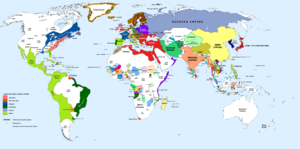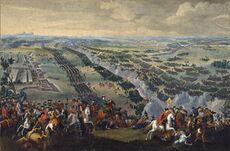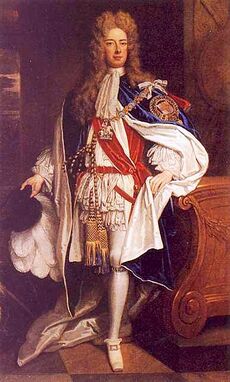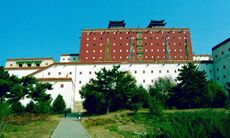قرن 18
| الألفية: | الألفية 2 |
|---|---|
| القرون: | |
| خطوط زمنية: | |
| زعماء الدول: |
|
| العقود: | |
| التصنيفات: | المواليد – الوفيات التأسيسات – الانحلالات |
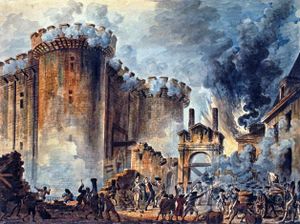
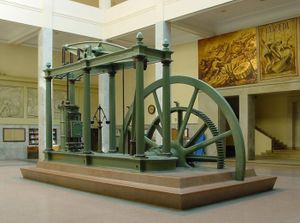
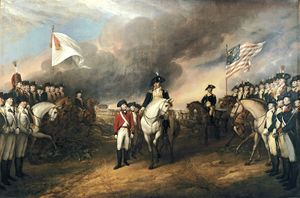
القرن الثامن عشر هو الفترة الزمنية الممتدة من اليوم الأول لعام 1701 إلى اليوم الأخير من عام 1800 حسب التقويم الميلادي. خلال هذا القرن تَتوّج عصر التنوير بقيام الثورة الفرنسية والثورة الأمريكية فيما بعد. ازداد العلم والفلسفة بشكل بارز. حلم الفلاسفة بعصر أكثر إشراقا. تحول هذا الحلم إلى واقع مع الثورة الفرنسية، على الرغم من التعرض للخطر في وقت لاحق في عهد الإرهاب (1793–1794) من قبل ماكسمليان روبسبير. في البداية، العديد من الممالك في أوروبا اعتنقت أهداف حركة التنوير الفلسفية، ولكن مع الثورة الفرنسية كانوا يخشون فقدان قوتهم وشكلوا تحالفات واسعة للثورة المضادة. [1][2][3]
Western historians have occasionally defined the 18th century otherwise for the purposes of their work. For example, the "short" 18th century may be defined as 1715–1789, denoting the period of time between the death of Louis XIV of France and the start of the French Revolution, with an emphasis on directly interconnected events.[4][5] To historians who expand the century to include larger historical movements, the "long" 18th century[6] may run from the Glorious Revolution of 1688 to the Battle of Waterloo in 1815[7] or even later.[8]
The period is also known as the "century of lights" or the "century of reason". In continental Europe, philosophers dreamed of a brighter age. For some, this dream turned into a reality with the French Revolution of 1789, though this was later compromised by the excesses of the Reign of Terror. At first, many monarchies of Europe embraced Enlightenment ideals, but in the wake of the French Revolution they feared loss of power and formed broad coalitions to oppose the French Republic in the French Revolutionary Wars.
The 18th century also marked the end of the Polish–Lithuanian Commonwealth as an independent state. Its semi-democratic government system was not robust enough to rival the neighboring states of the Prussia, Russia, and Austria, which partitioned the Polish–Lithuanian Commonwealth between themselves, changing the landscape of Central Europe and politics for the next hundred years.
The Ottoman Empire experienced an unprecedented period of peace and economic expansion, taking part in no European wars from 1740 to 1768. As a result, the empire was not exposed to Europe's military improvements of the Seven Years' War. The Ottoman Empire military consequently lagged behind and suffered several defeats against Russia in the second half of the century. In Southwest and Central Asia, Nader Shah led successful military campaigns and major invasions, which indirectly led to the founding of the Durrani Empire.
The European colonization of the Americas and other parts of the world intensified and associated mass migrations of people grew in size as part of the Age of Sail. European colonization intensified in present-day Indonesia, where the Dutch East India Company established increasing levels of control over the Mataram Sultanate. Mainland Southeast Asia would be embroiled in the Konbaung–Ayutthaya Wars and the Tây Sơn rebellion, while in East Asia, the century marked the High Qing era and the continual seclusion policies of the Tokugawa shogunate.
Various conflicts throughout the century, including the War of the Spanish Succession and the French and Indian War saw Great Britain triumphing over its European rivals to become the preeminent colonial power in Europe. However, Britain lost its colonies in North America after the American Revolutionary War, which went on to form the United States, initiating the decolonization of the Americas. The European colonization of Australia and New Zealand began during the late half of the century.
In the Indian subcontinent, the death of Mughal emperor Aurangzeb marked the end of medieval India and the beginning of an increasing level of European influence and control in the region, which coincided with a period of rapid Maratha expansion. After the reign of Aurangzeb, the Mughal Empire became less powerful. In 1739, Nader Shah invaded and defeated the Mughal Empire. Later, his general Ahmad Shah Abdali scored another defeat against the Mughals in the Third Battle of Panipat in 1761.[9] By the middle of the century, the British East India Company began to conquer the eastern parts of India, a process which accelerated after their victory over the Mughal emperor, Nawab of Bengal and their French allies at the Battle of Plassey.[10][9] Mughal emperor transformed into mere puppet of British.[9] By the end of the century, Company rule in India had come to cover more regions within South Asia, the British would also expand to the south, participating in the Anglo-Mysore Wars against the Kingdom of Mysore, governed by Tipu Sultan and his father Hyder Ali.[11][12]
. . . . . . . . . . . . . . . . . . . . . . . . . . . . . . . . . . . . . . . . . . . . . . . . . . . . . . . . . . . . . . . . . . . . . . . . . . . . . . . . . . . . . . . . . . . . . . . . . . . . . . . . . . . . . . . . . . . . . . . . . . . . . . . . . . . . . . . . . . . . . . . . . . . . . . . . . . . . . . . . . . . . . . . .
أحداث
1701–1750
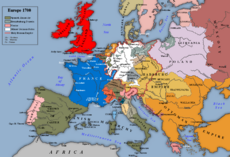
- 1700 أندلاع حرب الشمال العظمى بهجوم تحالف مكون من روسيا القيصرية والدنمارك- النرويج والكومنولث البولندي اللتواني وساكسونيا ضد الإمبراطورية السويدية للهيمنة على بحر البلطيق نجحت السويد في صد الهجوم وهزيمة الجيش الروسي.
- 1701 وفاة كارلوس الثاني ملك إسبانيا في نوفمبر آخر ملوك سلالة هابسبورغ ورث مملكته فيليب دوق أنجو حفيد لويس الرابع عشر ملك فرنسا باسم فيليب الخامس ملك إسبانيا فاندلعت حرب الخلافة الإسبانية عندما طالب الإمبراطور الروماني ليوبولد الأول بعرش أسبانيا.
- 1701 تحالف إنجلترا وجمهورية هولندا مع الإمبراطورية الرومانية المقدسة في حرب الخلافة الإسبانية ضد فرنسا وإسبانيا لضبط التوسع الفرنسي في أوروبا.
- 1701 نالت آل هوهنتسولرن صفة الملكية لإمارة بروسيا التي شملت كافة أنحاء مقاطعة براندنبورغ حيث توج الأمير الناخب فريدريش الثالث ملكا على عرش مملكة بروسيا باسم فريدريك الأول ملك بروسيا.
- 1702 وفاة ويليام الثالث ملك إنجلترا واسكتلندا وايرلندا في مارس وخلفه آن ملكة إنجلترا وايرلندا.
- 1702 أمتدت معارك حرب الخلافة الإسبانية من أوروبا لأمريكا الشمالية وعرفت بين المستوطنين الإنجليز بحرب الملكة آن.
- 1702 خلال حرب الشمال العظمى نجح الجيش السويدي في غزو بولندا.
- 1703 وفاة السلطان العثماني مصطفى الثاني في ديسمبر وخلفه اخيه أحمد الثالث.
- 1705 وفاة الامبراطور الروماني ليوبولد الأول في مايو وخلفه ابنه يوزف الأول (إمبراطور روماني مقدس).
- 1706 خلال حرب الشمال العظمى سيطرت السويد علي بولندا فعزلت فريدرش اغسطس الثاني ملك بولندا التابع لهابسبورغ وتوجت ستانيسلاف الأول تابعا للسويد.
- 1707 وحدت ممالك إنجلترا التي شملت ويلز واسكتلندا لتشكيل مملكة بريطانيا العظمى تشمل جزيرة بريطانيا العظمى بأكملها وجزرها النائية..
- 1709 أستعادت روسيا القيصرية السيطرة علي بولندا واعادوا الملك فريدرش اغسطس الثاني وفر ستانيسلاف الأول الي فرنسا.
- 1709 خلال حرب الشمال العظمى رغم تمكن كارل الثاني عشر ملك السويد من تحقيق عدة انتصارات على روسيا القيصرية إلا أنه هزم هزيمة ساحقة في معركة بولتافا باوكرانيا التي قضت على الجزء الأهم من جيشه وأرغمته على الفرار إلى مدينة بندر العثمانية حيث قدم طلباً رسمياً للجوء للسلطان العثماني أحمد الثالث.
- 1710 طارد الجيش الروسي الجيش السويدي داخل الأراضي العثمانية مما اعتبر سبباً للحرب بين روسيا القيصرية والدولة العثمانية.
- 1711 أجبر الجيش العثماني الجيش الروسي علي الاستسلام فعرض القيصر الروسي بطرس الأكبر اعادة ميناء آزوف للعثمانيين مقابل السماح له بالانسحاب بجيشه.
- 1711 وفاة الامبراطور يوزف الأول في ابريل وخلفه شقيقه كارل السادس (إمبراطور روماني مقدس).
- 1713 وفاة فريدريك الأول ملك بروسيا في فبراير وخلفه أبنه فريدرش فيلهلم الأول ملك بروسيا.
- 1713 أنتهت حرب الخلافة الإسبانية بتوقيع معاهدة أوترخت التي نصت علي بقاء فيليب الخامس ملك إسبانيا ولكنه أزيح من سلسلة خلافة العرش الفرنسي لتجنب حدوث أي اتحاد مستقبلي بين مملكتي إسبانيا وفرنسا ونالت النمسا معظم إقطاعيات إسبانيا في ايطاليا وهولندا.
- 1714 رفض الإمبراطور الروماني كارل السادس معاهدة أوترخت وأستمرت الحرب بين فرنسا والنمسا حتي وقعت الدولتان معاهدة راستات.
- 1714 وفاة آن ملكة بريطانيا العظمي وأيرلندا آن في اغسطس وخلفها جورج الأول ملك بريطانيا العظمى وأيرلندا.
- 1714 خلال حرب الشمال العظمى احتل الجيش الروسي فنلندا بعد انتصاره علي الجيش السويدي.
- 1715 وفاة لويس الرابع عشر ملك فرنسا في سبتمبر وخلفه حفيده لويس الخامس عشر ملك فرنسا.
- 1715 أعلن العثمانيون الحرب علي جمهورية البندقية لاستعادة بلاد المورة وبالفعل تمكن الجيش العثماني من أستعادة السيطرة علي بلاد المورة.
- 1718 قتل كارل الثاني عشر ملك السويد خلال حرب الشمال العظمى في نوفمبر وخلفه فريدريك الأول وفي عهده تحول نظام الحكم في السويد الي نظام برلماني بانتقال السلطة من الملك الي البرلمان وسمي هذا العصر بعصر الحرية.
- 1720 بعد استعادة العثمانيين لبلاد المورة استنجد البنادقة بالنمسا التي سارعت لقتال الجيش العثماني الذي انهزم واجبر علي توقيع معاهدة باساروفجا التي قضت بإعادة جزيرة كريت للبندقية وتسليم بلغراد ومعظم بلاد الصرب وجزءًا من الأفلاق للنمسا وأن تظل البندقية مسيطرة على سواحل دلماسيا مقابل عودة بلاد المورة للعثمانيين.
- 1721 تقلصت السلطات الملكية في عهد جورج الأول ملك بريطانيا العظمى وأيرلندا وبدأت بريطانيا الانتقال لنظام مجلس الوزراء الحديث يقوده روبرت والبول أول رئيس وزراء فعلي لبريطانيا.
- 1721 بعد هزيمة السويد انهت معاهدة نيستادحرب الشمال العظمى وبموجبها استحوزت روسيا على استونيا وليفونيا وإيجريا وأجبرت السويد على التخلي عن مساحات كبيرة من الأراضي وبالتالي فقدت مكانتها كإمبراطورية مهيمنة على بحر البلطيق وبرزت الإمبراطورية الروسية كواحدة من أمم أوروبا العظمي.
- 1722 أندلعت الحرب الروسية الصفوية في محاولة لتوسيع النفوذ الروسي في بحر قزوين ومنع الدولة العثمانية من تحقيق اي مكاسب في المنطقة على حساب الدولة الصفوية الضعيفة انتهت الحرب بهزيمة الصفويين وتنازلهم عن الكثير من أراضيهم في القوقاز شمال بلاد فارس لروسيا.
- 1725 وفاة القيصر الروسي بطرس الأكبر في فبراير وخلفه زوجته كاثرين الأولى.
- 1725 وفاة جورج الأول ملك بريطانيا العظمى وايرلندا في يونيو وخلفه ابنه جورج الثاني ملك بريطانيا العظمى وأيرلندا.
- 1727 وفاة الإمبراطورة الروسية كاثرين الأولى في مايو وخلفها حفيدها بطرس الثاني في الثانية عشر من عمره.
- 1730 وفاة القيصر الروسي بطرس الثاني في يناير وخلفه آنا إيفانوفنا.
- 1730 لتعويض ماخسروه في أوروبا أتجه العثمانيون شرقا نحو الدولة الصفوية فاحتلوا أرمينيا وجورجيا وبسبب رغبة السلطان العثماني أحمد الثالث في عقد السلم بين الطرفين ثارت الإنكشارية التي أرادت استمرار الحرب وعزلوا السلطان وخلفه ابن اخيه محمود الاول.
- 1733 وفاة فريدرش اغسطس الثاني ملك بولندا في فبراير فاندلعت حرب الخلافة البولندية بين ابنه أغسطس الثالث ملك بولندا المدعوم من روسيا وهابسبورغ والملك السابق ستانيسلاف الأول المدعوم من فرنسا.
- 1735 أعلنت الإمبراطورية الروسية والنمسا الحرب على بولندا وقامت روسيا باحتلال بولندا.
- 1738 رغبت فرنسا التحالف مع الدولة العثمانية لإنقاذ بولندا من كل من النمسا وروسيا لكن أرضت النمسا فرنسا بمعاهدة فيينا التي أنهت حرب الخلافة البولندية بتتويج حليف روسيا وهابسبورغ أغسطس الثالث ملك بولندا مقابل دوقية لورين ستانيسلاف الأول حليف فرنسا وتؤل الي فرنسا بعد وفاته.
- 1739 اندلعت الحرب بين الإمبراطورية الروسية والدولة العثمانية فتمكن العثمانيون من وقف تقدم الروس في إقليم البغدان كما أوقفوا تقدم النمسا في البوسنة والصرب والأفلاق.
- 1739 أنتصر الجيش العثماني علي جيش النمسا التي انسحبت من الحرب وطلبت الصلح عن طريق فرنسا وتم توقيع معاهدة صلح في بلغراد تنازلت فيه النمسا عن بلغراد وعن بلاد الصرب والأفلاق وتعهدت روسيا بعدم بناء سفن في البحر الأسود وهدم قلاع ميناء آزوف.
- 1740 وفاة فريدرش فيلهلم الأول ملك بروسيا في مايو وخلفه ابنه فريدرش الثاني
- 1740 وفاة الإمبراطورة الروسية آنا إيفانوفنا في أكتوبر وخلفها ابن اختها ايفان السادس في عمر الشهرين تحت وصاية والدته آنا ليوبولدوفنا.
- 1740 بعد وفاة الإمبراطور الروماني كارل السادس في أكتوبر أصبحت ابنته ماريا تريزا وريثة له كملكة على المجر وكرواتيا وبوهيميا وأرشيدوقة على النمسا حسب مرسوم الضمان الوراثي الذي اصدره الإمبراطور كارل السادس قبل وفاته.
- 1740 خرق فريدرش الثاني ملك بروسيا مرسوم الضمان الوراثي معارضا حكم ماريا تريزا وغزا سيليزيا لتندلع حرب الخلافة النمساوية.
- 1741 أطيح بالقيصر الروسي الطفل إيفان السادس في ديسمبر وتولت إليزابيث إمبراطورة روسيا
- 1743 أعلنت السويد الحرب علي الإمبراطورية الروسية في محاولة لاستعادة الاراضي التي فقدتها في حرب الشمال العظمى ولكنها انتهت باحتلال روسيا لفنلندا.
- 1745 أنتخب فرانز ستيفن زوج ماريا تيريزا إمبراطوراً لالإمبراطورية الرومانية المقدسة بأسم فرانسيس الأول
- 1746 وفاة فيليب الخامس ملك إسبانيا في يوليو وخلفه ابنه فرناندو السادس ملك إسبانيا
- 1748 أنتهت حرب الخلافة النمساوية بمعاهدة اخن وبموجب هذه المعاهدة فقدت ماريا تيريزا مقاطعة سيليزيا الغنية لفريدرش الثاني ملك بروسيا.
1751–1800
- 1751 وفاة فريدريك الأول ملك السويد وخلفه أدولف فريدريك.
- 1756 أندلعت حرب السنوات السبع بين مملكة بروسيا والنمسا من أجل السيطرة على ألمانيا. تدخلت بريطانيا لجانب بروسيا وفرنسا لجانب النمسا كان تدخل بريطانيا وفرنسا من أجل السيطرة على مستعمرات أمريكا الشمالية.
- 1759 وفاة فرناندو السادس ملك إسبانيا في اغسطس وخلفه اخيه كارلوس الثالث ملك إسبانيا.
- 1760 وفاة جورج الثاني ملك بريطانيا العظمى وايرلندا في أكتوبر وخلفه حفيده جورج الثالث.
- 1761 وفاة إليزابيث إمبراطورة روسيا في ديسمبر وخلفها ابن شقيقتها بيتر الثالث.
- 1762 أطاحت كاترين بزوجها القيصر الروسي بيتر الثالث في يونيو وتوجت بأسم كاترين الثانية إمبراطورة روسيا. انتعشت روسيا انتعاشًا كبيرًا في ظل الحُكم الكاتريني فتوسعت أراضي الإمبراطورية الروسية على حساب جيرانها وازدادت قوتها العسكرية حتي أضطرت أوروبا للاعتراف بها كقوة عُظمى.
- 1763 وفاة أغسطس الثالث ملك بولندا وانتخب خلفه ستانيسواف أغسطس بونياتوفسكي.
- 1763 أنتهت حرب السنوات السبع بعقد معاهدة باريس (1763) حيث ثبتت الحرب مركز مملكة بروسيا كدولة عظمى وبقيت سيليزيا تحت الحكم البروسي وحسمت النزاع بين فرنسا وبريطانيا التي اصبحت الدولة الاستعمارية الكبرى في العالم على حساب فرنسا التي فقدت معظم مستعمراتها في أمريكا الشمالية والهند لبريطانيا.
- 1765 وفاة الامبراطور الروماني فرانسيس الأول في اغسطس وخلفه ابنه جوزيف الثاني.
- 1769 أندلعت الحرب بين الإمبراطورية الروسية والدولة العثمانية مجددا بسبب اجتياح روسيا لبولندا وقيام الرهبان الروس بإثارة الفتنة في الصرب وبلغاريا والجبل الأسود. ولم يكن قادة العثمانيين على قدر من الكفاءة فلحقت بهم الهزائم المتتالية واستولى الروس على بلاد القرم.
- 1771 وفاة أدولف فريدريك ملك السويد في فبراير وخلفه ابنه غوستاف الثالث الذي انقلب علي نظام الحكم البرلماني واعاد السلطة بيد الملك.
- 1772 قام كل من الإمبراطورية الروسية ومملكة بروسيا وملكية هابسبورغ بتقسيم أراضي الكومنولث البولندي الليتواني بينهم لتوسيع نفوذهم إقليميا فيما يسمي تقاسم بولندا الأول.
- 1774 وفاة السلطان العثماني مصطفى الثالث في يناير وخلفه اخيه السلطان عبد الحميد الأول. الذي طلب الصلح مع و
- 1774 عقد معاهدة كيتشوك كاينارجي بين الإمبراطورية الروسية والدولة العثمانية وبمقتضى هذه المعاهدة الجائرة انفصلت خانية القرم عن الدولة العثمانية ومنح الأفلاق والبغدان الاستقلال الذاتي تحت السيادة العثمانية مع إعطاء روسيا حق التدخل في اختيار حكامها كما أعطت لروسيا حق رعاية السكان الأرثوذكس الذين يعيشون في البلاد العثمانية.
- 1774 وفاة لويس الخامس عشر ملك فرنسا في مايو وخلفه حفيده لويس السادس عشر ملك فرنسا.
- 1775 أندلعت حرب الإستقلال الأمريكية بين بريطانيا العظمي ومستعمراتها الثلاثة عشر في أمريكا.
- 1776 قاد جورج واشنطن جيش المتطوعين بدعم من الجيش الفرنسي في حرب الإستقلال الأمريكية وأعلن الأستقلال في 4 يوليو من قبل ممثلي الولايات المتحدة الأمريكية خلال مؤتمر فيلادلفيا الثالث.
- 1783 أنتهت حرب الإستقلال الأمريكية بمعاهدة باريس (1783) التي صدقت علي أستقلال الولايات المتحدة الأمريكية.
- 1786 وفاة فريدرش الثاني ملك بروسيا في أغسطس وخلفه ابن اخيه فريدرش فيلهلم الثاني ملك بروسيا.
- 1788 وفاة كارلوس الثالث ملك إسبانيا في ديسمبر وخلفه ابنه الملك كارلوس الرابع ملك إسبانيا.
- 1789 تحالفت الإمبراطورية الروسية مع ملكية هابسبورغ ضد الدولة العثمانية أحتلت الجيوش النمساوية صربيا واحتلت روسيا بساربيا ورومانيا.
- 1789 وفاة السلطان العثماني عبد الحميد الأول في ابريل وخلفه أبن اخيه سليم الثالث الذي أمر الجيوش بالتوجه نحو النمسا ولكن الجيوش العثمانية هزمت في معركة يوزا.
- 1789 أندلعت الثورة الفرنسية علي لويس السادس عشر ملك فرنسا بسبب الفقر والازمة الاقتصادية. أقتحم الفرنسيون سجن الباستيل وعزلوا الملك وتوج ابنه لويس السابع عشر وإلغاء الملكية المطلقة وأصبحت فرنسا ملكية دستورية.
- 1790 وفاة الإمبراطور الروماني جوزيف الثاني في فبراير وخلفه اخيه ليوبولد الثاني.
- 1791 تبنى الكومنولث البولندي الليتواني جهود إصلاح ضخمة وكتب دستور مايو (أول دستور مكتوب في التاريخ الاوروپي المعاصر).
- 1792 عارض نبلاء بولنديون وليتوانيون الدستور الجديد وانشأوا كونفدرالية تارغوويكا في سانت بطرسبرج بدعم من الإمبراطورة الروسية كاترين الثانية.
- 1792 أندلعت الحرب الروسية البولندية بين الكومنولث البولندي الليتواني من جهة وكونفدرالية تارغوويكا والإمبراطورية الروسية انتهت الحرب عندما قرر الملك البولندي ستانيسواف أغسطس اللجوء لحل دبلوماسي طلب فيه وقف إطلاق النار مع الروس وانضم إلى كونفدرالية تارغوويكا كما طلبت الإمبراطورية الروسية ذلك منه.
- 1792 خشية تطورات الثورة الفرنسية عقدت ملكية هابسبورغ معاهدة زشتوي التي نصت علي إعادة صربيا الي الدولة العثمانية وعقدت الإمبراطورية الروسية معاهدة ياش وفيها خسرت الدولة العثمانية آزوف وبساربيا وبلاد القرم ولكنها استردت اوزي ورومانيا.
- 1792 نتيجه لاستمرار العنف والاضطرابات السياسيه في فرنسا عزل الملك لويس السابع عشر واعلنت الجمهورية الفرنسية الأولى.
- 1792 وفاة الامبراطور الروماني ليوبولد الثاني في مارس وخلفه ابنهفرانتس الثاني (إمبراطور روماني مقدس).
- 1792 نجح قادة حزب الجبل الفرنسي بقيادة روبسبير في تهميش حزب الجيرونديون والسيطرة على الحكم واتسم حكمهم بالعنف السياسي واعدام المعارضين حتي سمي عهد الإرهاب.
- 1792 تحالفت دول اوروبا ضد الثورة الفرنسية خشيه تصدير الثوره لبلدانهم ولكن استطاع الجيش الفرنسي صد هجوم تحالف يقوده بروسيا والنمسا. أعدمت الحكومة الثورية الفرنسية لويس السادس عشر ملك فرنسا السابق بعد محاكمة علنية فانضمت إسبانيا والبرتغال للتحالف المكون ضد فرنسا.
- 1792 أعلنت الجمهورية الفرنسية الأولى الحرب على بريطانيا العظمى والجمهورية الهولندية وقد أعدت فرنسا مئات الآلاف من الرجال عن طريق استخدام سياسة التجنيد الشامل واستطاع الجيش الفرنسي احتلال بلجيكا ومنطقة الراين في المانيا.
- 1793 التقسيم الثاني لبولندا اقره البرلمان البولندي في محاولة لمنع الضم الكامل لصالح المستفيدين وهم الإمبراطورية الروسية ومملكة بروسيا.
- 1794 قاد تاديوش كوسيوسكو قائد عسكري بولندي انتفاضة شعبية في بولندا ضد الإمبراطورية الروسية حتي تم القبض عليه.
- 1795 بعد هزيمة الانتفاضة الشعبية في بولندا تم التقسيم الثالث لبولندا الذي أنهى وجود الكومنولث البولندي الليتواني المستقل.
- 1795 أندلعت الثورة في الجمهورية الهولندية بمساعدة الجيش الفرنسي وانشاء الجمهورية الباتافية تابعة لفرنسا.
- 1795 بعد تفشي حالات القمع والاعدام للمعارضين بحجة حماية الثورة تم ازاحة حزب الجبل الفرنسي من السلطة واعدام روبسبير وتشكلت حكومة المديرين من قبل الجمهوريين المعتدلين لقيادة الدولة الفرنسية.
- 1796 وفاة الامبراطورة الروسية كاترين الثانية في نوفمبر وخلفها ابنها القيصر بافل الاول.
- 1797 أرسلت الحكومة الثورية في فرنسا جيش بقيادة نابليون بونابرت لغزو ايطاليا وسويسرا وبالفعل احتل اجزاء كبيرة من ايطاليا وانشاء الجمهورية الألبية كدولة دمية تابعة لفرنسا.
- 1797 وفاة فريدرش فيلهلم الثاني ملك بروسيا في نوفمبر وخلفه ابنه فريدرش فيلهلم الثالث ملك بروسيا.
- 1798 أبحر القائد الفرنسي نابليون بونابرت من مالطا الي الاسكندرية في مصر واستطاع هزيمة الدولة المملوكية واحتلال مصر مما كان سببا في انهيار الصداقة الفرنسية العثمانية التي قامت من عهد السلطان العثماني سليمان القانوني.
- 1798 نظمت بريطانيا العظمي والنمسا تحالف جديد ضد الجمهورية الفرنسية الأولى وضم لأول مرة الإمبراطورية الروسية.
- 1799 أستعادت النمسا سيطرتها علي شمال إيطاليا مرة اخري.
- قام القائد الفرنسي نابليون بونابرت بعزل حكومة المديرين وأنشأ بدلاً منها حكومة القناصل وتقلّد هو بنفسه منصب القنصل الأول .
. . . . . . . . . . . . . . . . . . . . . . . . . . . . . . . . . . . . . . . . . . . . . . . . . . . . . . . . . . . . . . . . . . . . . . . . . . . . . . . . . . . . . . . . . . . . . . . . . . . . . . . . . . . . . . . . . . . . . . . . . . . . . . . . . . . . . . . . . . . . . . . . . . . . . . . . . . . . . . . . . . . . . . . .
شخصيات هامة
اختراعات واكتشافات
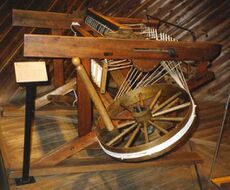
- 1709: The first piano was built by Bartolomeo Cristofori
- 1711: Tuning fork was invented by John Shore
- 1712: Steam engine invented by Thomas Newcomen
- 1714: Mercury thermometer by Daniel Gabriel Fahrenheit
- 1717: Diving bell was successfully tested by Edmond Halley, sustainable to a depth of 55 ft
- c. 1730: Octant navigational tool was developed by John Hadley in England, and Thomas Godfrey in America
- 1733: Flying shuttle invented by John Kay
- 1736: Europeans encountered rubber – the discovery was made by Charles Marie de La Condamine while on expedition in South America. It was named in 1770 by Joseph Priestley
- c. 1740: Modern steel was developed by Benjamin Huntsman
- 1741: Vitus Bering discovers Alaska
- 1745: Leyden jar invented by Ewald Georg von Kleist was the first electrical capacitor
- 1751: Jacques de Vaucanson perfects the first precision lathe
- 1752: Lightning rod invented by Benjamin Franklin
- 1753: The first clock to be built in the New World (North America) was invented by Benjamin Banneker.
- 1755: The tallest wooden Bodhisattva statue in the world is erected at Puning Temple, Chengde, China.
- 1764: Spinning jenny created by James Hargreaves brought on the Industrial Revolution
- 1765: James Watt enhances Newcomen's steam engine, allowing new steel technologies
- 1761: The problem of longitude was finally resolved by the fourth chronometer of John Harrison
- 1763: Thomas Bayes publishes first version of Bayes' theorem, paving the way for Bayesian probability
- 1768–1779: James Cook mapped the boundaries of the Pacific Ocean and discovered many Pacific Islands
- 1774: Joseph Priestley discovers "dephlogisticated air", oxygenThe Chinese Putuo Zongcheng Temple of Chengde, completed in 1771, during the reign of the Qianlong Emperor.
- 1775: Joseph Priestley first synthesis of "phlogisticated nitrous air", nitrous oxide, "laughing gas"
- 1776: First improved steam engines installed by James Watt
- 1776: Steamboat invented by Claude de Jouffroy
- 1777: Circular saw invented by Samuel Miller
- 1779: Photosynthesis was first discovered by Jan Ingenhousz
- 1781: William Herschel announces discovery of Uranus
- 1784: Bifocals invented by Benjamin Franklin
- 1784: Argand lamp invented by Aimé Argand[13]
- 1785: Power loom invented by Edmund Cartwright
- 1785: Automatic flour mill invented by Oliver Evans
- 1786: Threshing machine invented by Andrew Meikle
- 1787: Jacques Charles discovers Charles's law
- 1789: Antoine Lavoisier discovers the law of conservation of mass, the basis for chemistry, and begins modern chemistry
- 1798: Edward Jenner publishes a treatise about smallpox vaccination
- 1798: The Lithographic printing process invented by Alois Senefelder[14]
- 1799: Rosetta Stone discovered by Napoleon's troops
الإنجازات الأدبية والفلسفية
- 1703: The Love Suicides at Sonezaki by Chikamatsu first performed
- 1704–1717: One Thousand and One Nights translated into French by Antoine Galland. The work becomes immensely popular throughout Europe.
- 1704: A Tale of a Tub by Jonathan Swift first published
- 1712: The Rape of the Lock by Alexander Pope (publication of first version)
- 1719: Robinson Crusoe by Daniel Defoe
- 1725: The New Science by Giambattista Vico
- 1726: Gulliver's Travels by Jonathan Swift
- 1728: The Dunciad by Alexander Pope (publication of first version)
- 1744: A Little Pretty Pocket-Book becomes one of the first books marketed for children
- 1748: Chushingura (The Treasury of Loyal Retainers), popular Japanese puppet play, composed
- 1748: Clarissa by Samuel Richardson
- 1749: The History of Tom Jones, a Foundling by Henry Fielding
- 1751: Elegy Written in a Country Churchyard by Thomas Gray published
- 1751–1785: The French Encyclopédie
- 1755: A Dictionary of the English Language by Samuel Johnson
- 1758: Arithmetika Horvatzka by Mihalj Šilobod Bolšić
- 1759: Candide by Voltaire
- 1759: The Theory of Moral Sentiments by Adam Smith
- 1759–1767: Tristram Shandy by Laurence Sterne
- 1762: Emile: or, On Education by Jean-Jacques Rousseau
- 1762: The Social Contract, Or Principles of Political Right by Jean-Jacques Rousseau
- 1774: The Sorrows of Young Werther by Goethe first published
- 1776: Ugetsu Monogatari (Tales of Moonlight and Rain) by Ueda Akinari
- 1776: The Wealth of Nations, foundation of the modern theory of economy, was published by Adam Smith
- 1776–1789: The History of the Decline and Fall of the Roman Empire was published by Edward Gibbon
- 1779: Amazing Grace published by John Newton
- 1779–1782: Lives of the Most Eminent English Poets by Samuel Johnson
- 1781: Critique of Pure Reason by Immanuel Kant (publication of first edition)
- 1781: The Robbers by Friedrich Schiller first published
- 1782: Les Liaisons dangereuses by Pierre Choderlos de Laclos
- 1786: Poems, Chiefly in the Scottish Dialect by Robert Burns
- 1787–1788: The Federalist Papers by Alexander Hamilton, James Madison, and John Jay
- 1788: Critique of Practical Reason by Immanuel Kant
- 1789: Songs of Innocence by William Blake
- 1789: The Interesting Narrative of the Life of Olaudah Equiano by Olaudah Equiano
- 1790: Journey from St. Petersburg to Moscow by Alexander Radishchev
- 1790: Reflections on the Revolution in France by Edmund Burke
- 1791: Rights of Man by Thomas Paine
- 1792: A Vindication of the Rights of Woman by Mary Wollstonecraft
- 1794: Songs of Experience by William Blake
- 1798: Lyrical Ballads by William Wordsworth and Samuel Taylor Coleridge
- 1798: An Essay on the Principle of Population published by Thomas Malthus
- (mid-18th century): The Dream of the Red Chamber (authorship attributed to Cao Xueqin), one of the most famous Chinese novels
الأعمال الموسيقية
- 1711: Rinaldo, Handel's first opera for the London stage, premiered
- 1721: Brandenburg Concertos by J.S. Bach
- 1723: The Four Seasons, violin concertos by Antonio Vivaldi, composed
- 1724: St John Passion by J.S. Bach
- 1727: St Matthew Passion composed by J.S. Bach
- 1733: Hippolyte et Aricie, first opera by Jean-Philippe Rameau
- 1741: Goldberg Variations for harpsichord published by Bach
- 1742: Messiah, oratorio by Handel premiered in Dublin
- 1749: Mass in B minor by J.S. Bach assembled in current form
- 1751: The Art of Fugue by J.S. Bach
- 1762: Orfeo ed Euridice, first "reform opera" by Gluck, performed in Vienna
- 1786: The Marriage of Figaro, opera by Mozart
- 1787: Don Giovanni, opera by Mozart
- 1788: Jupiter Symphony (Symphony No.41) composed by Mozart
- 1791: The Magic Flute, opera by Mozart
- 1791–1795: London symphonies by Haydn
- 1798: The Pathétique, piano sonata by Beethoven
- 1798: The Creation, oratorio by Haydn first performed
المراجع
- ^ "A guide to Scottish clans". Retrieved 2009-04-25.
{{cite web}}: Cite has empty unknown parameter:|(empty string)=(help) - ^ . ISBN 978-0-19-822548-5. OCLC 185538307.
{{cite book}}: Missing or empty|title=(help); Unknown parameter|سنة=ignored (help); Unknown parameter|عنوان=ignored (help); Unknown parameter|مؤلف=ignored (help); Unknown parameter|ناشر=ignored (help) - ^ Encyclopædia Britannica's Great Inventions, موسوعة بريتانيكا Archived أغسطس 7, 2008 at the Wayback Machine
- ^ Anderson, M. S. (1979). Historians and Eighteenth-Century Europe, 1715–1789. Oxford University Press. ISBN 978-0-19-822548-5. OCLC 185538307.
- ^ Ribeiro, Aileen (2002). Dress in Eighteenth-Century Europe 1715–1789 (revised ed.). Yale University Press. ISBN 978-0-300-09151-9. OCLC 186413657.
- ^ Baines, Paul (2004). The Long 18th Century. London: Arnold. ISBN 978-0-340-81372-0.
- ^ Marshall, P. J., ed. (2001). The Oxford History of the British Empire: Volume II: The Eighteenth Century (Oxford History of the British Empire). Oxford University Press, USA. ISBN 978-0-19-924677-9. OCLC 174866045., "Introduction" by P. J. Marshall, page 1
- ^ O'Gorman, Frank (1997). The Long Eighteenth Century: British Political and Social History 1688–1832 (The Arnold History of Britain Series). A Hodder Arnold Publication. ISBN 978-0-340-56751-7. OCLC 243883533.
- ^ أ ب ت Chandra, Bipin. Mordern India (in الإنجليزية). India.
- ^ Campbell, John; Watts, William (1760). Memoirs of the Revolution in Bengal, anno Dom. 1757. A. Millar, London.
- ^ Parthasarathi, Prasannan (2011), Why Europe Grew Rich and Asia Did Not: Global Economic Divergence, 1600–1850, Cambridge University Press, p. 207, ISBN 978-1-139-49889-0, https://books.google.com/books?id=1_YEcvo-jqcC&pg=PA207
- ^ Allana, Gulam (1988). Muslim political thought through the ages: 1562–1947 (2 ed.). Pennsylvania State University, Pennsylvania: Royal Book Company. p. 78. ISBN 9789694070919. Retrieved 18 January 2013.
- ^ Encyclopædia Britannica's Great Inventions, Encyclopædia Britannica Archived أغسطس 7, 2008 at the Wayback Machine
- ^ Meggs, Philip B. A History of Graphic Design. (1998) John Wiley & Sons, Inc. p 146 ISBN 978-0-471-29198-5
للاستزادة
- Black, Jeremy and Roy Porter, eds. A Dictionary of Eighteenth-Century World History (1994) 890pp
- Klekar, Cynthia. “Fictions of the Gift: Generosity and Obligation in Eighteenth-Century English Literature.” Innovative Course Design Winner. American Society for Eighteenth-Century Studies: Wake Forest University, 2004. <Home | American Society for Eighteenth-Century Studies (ASECS)>. Refereed.
- Langer, William. An Encyclopedia of World History (5th ed. 1973); highly detailed outline of events online free
- Morris, Richard B. and Graham W. Irwin, eds. Harper Encyclopedia of the Modern World: A Concise Reference History from 1760 to the Present (1970) online
- Milward, Alan S, and S. B. Saul, eds. The economic development of continental Europe: 1780–1870 (1973) online; note there are two different books with identical authors and slightly different titles. Their coverfage does not overlap.
- Milward, Alan S, and S. B. Saul, eds. The development of the economies of continental Europe, 1850–1914 (1977) online
- The Wallace Collection, London, houses one of the finest collections of 18th-century decorative arts from France, England and Italy, including paintings, furniture, porcelain and gold boxes.
. . . . . . . . . . . . . . . . . . . . . . . . . . . . . . . . . . . . . . . . . . . . . . . . . . . . . . . . . . . . . . . . . . . . . . . . . . . . . . . . . . . . . . . . . . . . . . . . . . . . . . . . . . . . . . . . . . . . . . . . . . . . . . . . . . . . . . . . . . . . . . . . . . . . . . . . . . . . . . . . . . . . . . . .
وصلات خارجية
 Media related to قرن 18 at Wikimedia Commons
Media related to قرن 18 at Wikimedia Commons

